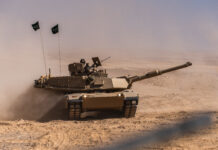Saudi Arabia is systematically investing in the development of its own defence industry and R&D capabilities. A remarkable 50% of defence spending is expected to be allocated domestically by 2030. This is an ambitious plan, and it remains to be seen whether the authorities in Riyadh will achieve their goal.
For decades, Saudi Arabia lacked any incentive to create a robust defence industry of its own. While some companies were established in the 1970s, its capabilities were primarily focused on assembly and maintenance rather than production, not to mention design. A key reason for this is that the government always had sufficient funds to acquire the latest solutions on the global market. At the same time, Saudi Arabia maintained a significant partnership with the West, which had no qualms with supplying Riyadh with substantial quantities of arms and equipment. According to PwC, between 2015 and 2019, Saudi Arabia predominantly imported from the United States (73%) and the United Kingdom (13%).
Saudi Arabia was the fifth-largest military spender in 2022 according to SIPRI (EUR 68 billion, a 16% growth compared to 2021), and is undergoing reshaping of its priorities. A decision to establish its own indigenous defence industry with a strong emphasis on R&D is due to a number of significant factors.
Firstly, Saudi Arabia’s freedom to purchase weaponry has notably diminished. The United States is no longer eager to supply Riyadh with all types of equipment, with President Biden pledging to halt arms sales due to the controversial war in Yemen. Similar doubts over arms exports have also surfaced in Germany, where Riyadh faced challenges in procuring Leopard 2A7 tanks and additional Eurofighters (though in the latter case, the ban was lifted in early January 2024). Developing its own capabilities gives Saudi Arabia more flexibility in a volatile and unpredictable world, particularly as the country seeks to strengthen its political independence.
Second, Saudi Arabia, allocating approximately 7.4% of its GDP to defence, aims to emulate regional states such as Qatar and diminish its reliance on energy exports. At the same time, Riyadh is aware of unexpected fluctuations in the oil market. For instance, Saudi crude oil exports in August 2023 reached their lowest level in 28 months. The gradual departure from being a rentier state requires more careful budget management. Simply put, the era of indiscriminately spending billions of dollars has come to an end.

Credit: USAF/Tech Sgt Michelle Larche
Third, Saudi Arabia is determined not to be left behind. Riyadh closely observes the successes of the United Arab Emirates (UAE), which has built its own defence industry from scratch in recent years and even developed an indigenous space programme, resulting in sending the first Emirati astronaut into space. EDGE represents the UAE’s defence gem. For Saudi Arabia – perceiving itself a leader among Arab monarchies in the Persian Gulf – a domestic defence industry is also a matter of prestige.
Riyadh’s vision
Saudi Arabia’s ambitious concept has been presented in detail in a government strategy, “Vision 2030”, which aims to foster a more diverse economy no longer reliant on revenues from the energy sector. Released in 2016, this strategy announced the creation of thousands of highly-skilled jobs and an increase in Saudi Arabia’s openness to foreign investments. As part of the strategy, there is an ongoing privatisation of state-owned assets, including leading companies, properties, and other assets. Consequently, Saudi Arabia aspires to improve its current position as the 19th largest economy in the world, to break into the top 15.
The defence industry is one of the pillars of this transition and in order to achieve its goals, Riyadh is insisting on a significant local workshare and investments from foreign partners. To this end, by January 2024, all foreign companies seeking business with the Saudi Government will be required to establish their regional headquarters in the country; this deadline is still in effect. Saudi Finance Minister Mohammad al-Jadaan was quoted by CNBC saying, “We definitely prioritise the companies that are bringing the value creation to where the value is consumed, that create high quality jobs for people in Saudi Arabia, Saudis and others, and that actually help us achieve our quality outcomes from our needs, whether it’s services or goods at a better and more meaningful way.”
Increasing the localisation rate — that is, the percentage of indigenous defence industries awarded contracts to supply the Saudi military and security forces — is one of the Government’s main objectives. When “Vision 2030” was announced, Saudi Arabia had the third-largest defence budget globally. However, at the same time, only up to 3% of its procurements came from local companies, with the rest sourced from abroad. According to official data from the General Authority for Military Industries (GAMI), in 2020, the localisation rate was 8%, before growing to 13.7% in 2022, while by mid-2023, it was declared to be “close to 15%”. The target is at least 50% by 2030.

Credit: SAMI
Moreover, Riyadh envisions a direct contribution from the defence industry of at least EUR 22.7 billion to the country’s GDP by 2030. The total projected job creation by 2030 is 100,000 roles (both direct and indirect), and the total value of more than 70 investment opportunities arising from localisation and the supply chain is EUR 65 billion. Saudi ambitions to expand national industrial capabilities do not exist in a vacuum but are based on solid foundations. One such foundation is the economy. According to The World Bank figures, Saudi Arabia’s GDP was approximately USD 874.16 billion in 2021, and grew to USD 1.11 trillion in 2022. It stands as the seventh-largest market globally in terms of foreign assets.
Saudi Arabian Military Industries (SAMI), a subsidiary of the Public Investment Fund (PIF), has been built up as a national champion. SAMI aims to be among the top 25 defence and security companies globally by 2030. The company has a comprehensive plan not only to be a major supplier of arms to the Saudi military and internal security forces, but also to be a regional hub providing various services, including repairs, overhauls, maintenance, production, design, and upgrades.
Capacity building
SAMI was established in May 2017 with the goal of reducing Saudi Arabia’s dependence on foreign technologies and suppliers. SAMI has since evolved into a conglomerate of various companies, acquired through a process of domestic consolidation. For instance, in 2019, the Aircraft Accessories & Components Company, established in 1988, was acquired. The following year, SAMI acquired the Advanced Electronics Company (AEC) to establish SAMI Advanced Electronics and launched SAMI Composites. In 2023, SAMI acquired a 51% stake in the Saudi Rotorcraft Support Company (with Boeing retaining the rest). While the company does not rule out acquiring foreign companies, it is not a current priority.
With 341 employees in 2020, SAMI rapidly expanded to 2,500 just two years later and then to almost 3,600 workers. Further increasing employment, however, presents challenges as there is a shortage of Saudi engineers. To address this, in 2022, GAMI established the National Academy of Military Industries, capable of accommodating up to 2,000 students.
Between 2021 and 2022, SAMI’s goal was to secure government contracts, while in 2023 and now in 2024, the company’s priority is to develop indigenous capabilities. To achieve this, SAMI launched the Land Systems Industrial Park in Riyadh in February 2023, announcing on their website that they aimed to “localise defence industries and build local capabilities in the engineering and design of ground systems, testing, and further qualifying systems”.

Credit: SAMI
SAMI, which made its debut at the Dubai Air Show in 2019, has entered into at least 12 major joint ventures with foreign companies. These agreements grant Saudi Arabia access to valuable technological know-how. For instance, through a partnership with Safran, SAMI will expand its MRO (maintenance, repair, and overhaul) capabilities to include helicopter engine maintenance and repair skills, specifically for Makila 1 and 2 engines used in Saudi helicopters, including the Super Puma and Panther models.
In collaboration with Lockheed Martin, Saudi Arabia will have the capacity to manufacture THAAD launchers and canisters, as well as to establish a Sniper advanced targeting pod (ATP) repair centre. Riyadh will also host the country’s Composites Manufacturing Center of Excellence following an agreement signed with Lockheed Martin in July 2022. ST Engineering’s involvement will provide Saudi Arabia with autonomous solutions, while Turkey’s Baykar will contribute to enhancing local expertise in electronic systems, mechanical parts, and aircraft structures. Additionally, Saudi Arabia will be able to locally produce Turkish Akinci UAVs.
Boeing is set to assist Saudi Arabia in establishing facilities and expertise for the maintenance, repair, and overhaul of helicopters. Simultaneously, a deal with Airbus Helicopters will provide Riyadh with essential helicopter airframe maintenance skills and bolster its repair capabilities for landing gears, engines, engine accessories, and rotor blades. To realise this objective, SAMI is currently constructing facilities at Malham, which will oversee activities related to helicopters, aircraft, and UAVs. These facilities are anticipated to become operational in 2024. Additionally, by 2026, facilities at Al Kharj are projected to become operational, focusing on production, assembly, and repair of light vehicles. Saudi Arabia has also forged industrial cooperation agreements with BAE Systems, Thales, L3Harris, Safran Helicopter Engines, John Cockerill, and Figeac Aero.
At the same time, the NCMS (National Company for Mechanical Systems), also headquartered in Riyadh, has finalised cooperation agreements with Turkish defence firms Roketsan and Aselsan. These agreements grant NCMS the rights to manufacture various types of munitions and sensors for UAVs. Both GAMI and SAMI are also making significant investments in cybersecurity. In October 2023, Riyadh launched a programme to develop indigenous communication systems, as well as autonomous systems for surveillance, reconnaissance, and combat. Technology transfer, including for armed UAVs, is also anticipated from China.
In October 2023, Seoul and Riyadh were reported to be in the “final stage of talks” regarding the procurement of air and missile defence systems. This is crucial for Saudi Arabia due to the ongoing missile threat from Yemen. It can be assumed that the agreement will also involve technology transfer, a priority for Saudi Arabia, as Riyadh is currently dependent on Western air and missile defence systems. At the same time, there are rumours that Saudi Arabia aims to collaborate with foreign partners in the field of directed-energy weapons.
Current strength
While the Saudi defence industry’s portfolio is currently modest, SAMI’s most significant project to date is the Al-Sarawat, a project related to the production of five new Avante 2200 class 104-metre corvettes in collaboration with Spain’s Navantia (both companies established a joint venture named SAMINavantia). The deal was signed in 2018, with the final ship launched in Spain in December 2021. Specific details regarding SAMI’s involvement are unclear, but it has been disclosed that the Saudi side provided the Hazem naval combat system, stated by Navantia to be “the first 100% Saudi marine operations management system that was developed through the transfer of technology from Navantia.”

Credit: Navantia
Another product showcased by SAMI is the Roaya remotely-controlled weapon station for light vehicles designed to be equipped with either a 7.62 mm or 12.7 mm machine gun, or a 40 mm grenade launcher. The company also boasts the Mulhim battle management system designed for brigade-level units and below. It has been disclosed that SAMI is currently seeking a foreign partner to further develop this system. The land division of SAMI is shrouded in mystery, with limited information available, only mentioning that its offerings encompass wheeled and tracked combat systems, tactical logistics trucks, unmanned vehicles, as well as wheeled and tracked artillery systems.
The influx of technology may occur through collaboration with Hanwha, with a relevant memorandum of agreement signed in 2019, and EDGE. The deal foresees that Saudi Arabia will co-manufacture 149 NIMR Jais (4×4) wheeled vehicles, with Saudi industry tasked with integrating indigenous systems. If the contract expands, and Riyadh opts to acquire more vehicles, there is a likelihood that production would be moved, at least partially, to Saudi Arabia. This is particularly plausible given the high demand for vehicles of this class. Potential users include not only the Royal Saudi Land Forces and the Saudi Arabian National Guard, but also other security agencies.
Saudi industry is also set to establish cooperation with Brazil, following the signing of a memorandum of understanding in August 2023. The deal involves several companies, including Embraer and Taurus, with rumours that the latter is considering opening a factory in Saudi Arabia. Within this framework, Brazil’s Avibras has already signed a cooperation agreement with Saudi company SCOPA, founded in 1979 in Riyadh and a partner of both US and European companies in various industrial sectors. Cooperation with Brazil is expected to cover military vehicles for, artillery, ballistic and guided rockets, as well as equipment for the space sector.
Further plans
At present, it is difficult to determine whether the Saudis will fulfil their ambitions, which includes a plan to have exports account for 30% of their business. Building their own capabilities – both in terms of facilities and the knowledge of their engineers – will take many years, and alongside successes, there will undoubtedly be setbacks. On the one hand, they have the potential for this, including substantial financial resources. The UAE and its EDGE company provide the best example and can serve as inspiration.
Saudi Arabia is no less attractive as a partner for foreign defence companies. However, on the other hand, they lack experience, and their ambitions pose a potential threat to the current defence-industrial status quo. In other words, leading defence companies are willing to sell their products and solutions, but they will not be pleased with the emergence of a significant competitor in the market.
The Saudi portfolio is currently modest and relies primarily on replicative solutions. Nevertheless, it can be anticipated that new productions will be presented during the World Defense Show 2024, organised in Riyadh in February by GAMI, which was established not only to manage military procurements but also to oversee and promote the indigenous defence sector. SAMI is slated to have the largest exhibition space at the show, both indoor and outdoor.
Robert Czulda












